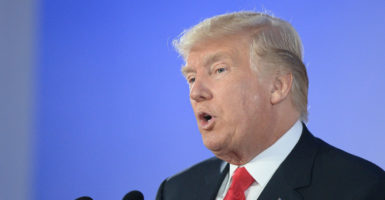How should the U.S. win the war of ideas against Islamism?
That question understandably provokes strong differences of opinion.
For example, honest people can disagree over the merits of the Obama administration’s Countering Violent Extremism policy, which George Selim, director of the Office of Community Partnerships, described as “the first federal assistance program devoted exclusively to providing local communities with the resources to counter violent extremism in the homeland.”
However, recent reports from certain quarters in the media have given an unfair representation of the new administration’s approach. This reporting has obscured rather than clarified, and ultimately does nobody any favors.
In January 2017, then secretary of homeland security, Jeh Johnson, announced $10 million worth of Countering Violent Extremism grants for 31 organizations.
But rather than accept this policy as a done deal, the incoming secretary, John Kelly, requested a review of the grants. When all was said and done, many groups kept their funding, some new grants were handed out, and others were cut.
This move should have been largely uncontroversial, considering the competing views that exist on how to best combat violent extremism and to deal with extremism more broadly.
But instead, some media players twisted this story to suggest that the Trump administration was somehow largely sympathetic to white supremacists.
Specifically, this stemmed from the administration’s decision to cut a $400,000 grant to Life After Hate, a group made up of former right-wing extremists, who planned to use the money for an online campaign targeting neo-Nazis.
This led to a string of stories in Politico, Newsweek, Think Progress, and the Chicago Tribune that focused on the Department of Homeland Security cutting funds to that particular group above any other. Salon called the decision “inexplicable.”
The subtext was clear: The Trump administration is soft on the far right.
Others were not as subtle in making that charge. The Muslim Public Affairs Council (which also had its grant cut) accused the Trump administration of turning a “blind eye” to white supremacy.
Christian Picciolini, one of Life After Hate’s founders, accused the administration of “refusing to acknowledge that white nationalist extremists are a major domestic terrorist threat.”
What these media sources ignored was a February 2017 Washington Free Beacon story highlighting some of Picciolini’s more unsavory tweets.
As the story points out, between November 2016 and January 2017, Picciolini took to Twitter to launch a series of incendiary insults against President Donald Trump. These tweets stated:
“OK, America. Time to put an end to this nonsense once and for all. The Nazis fooled us once and this time we BECAME the Nazis. #Revolt”.
“Shame on you, UNITED States of America. Last night, you committed suicide.”
half of us fought against him and will continue to do so. #notmypresident
— Christian Picciolini (@cpicciolini) November 9, 2016
Nice knowing ya. People like me, most journalists, POC, peace activists, cops & educators, wake up tomorrow with fresh targets on our backs.
— Christian Picciolini (@cpicciolini) November 9, 2016
In response to one Trump tweet, Picciolini responded, “F— you, a——-.”
Life After Hate surely does important work, but this is hardly sensible behavior for someone hoping to earn a government grant. It would also not be a great look for Homeland Security to spend Countering Violent Extremism money on a group founded by someone whose messaging appears a tad, well, extreme.
One would imagine that Picciolini would not have wanted to accept the money anyway, coming from an administration headed by an “a——” he thought needed to be overthrown and which possessed an agenda he had vowed to fight.
The media also seemed to overlook a $866,687 grant cut to a University of North Carolina project dealing with Islamism. (That’s more than double the amount of money Life After Hate was cut.)
The university’s program had been tasked with producing “videos and other materials to counteract jihadist propaganda that targets young people,” yet Homeland Security ultimately decided that was not an effective use of taxpayer money.
No one in the media seized on that example to accuse the Trump administration of being soft on Islamism, because such an accusation would be patently absurd. Yet when it came to the far right, no such restraint was in display.
The unglamorous truth is that, as a Homeland Security spokesperson commented, “The program has not been altered to focus on any one type of violent extremism.” He went on to note that there were 16 grants that were “equipped to handle all types of violent extremism, including white supremacist violent extremism.”
Preventing public misunderstanding on what “countering violent extremism” policy actually seeks to achieve is hard enough as it is. By twisting the narrative in the way it did, the media is only making that task harder.






























